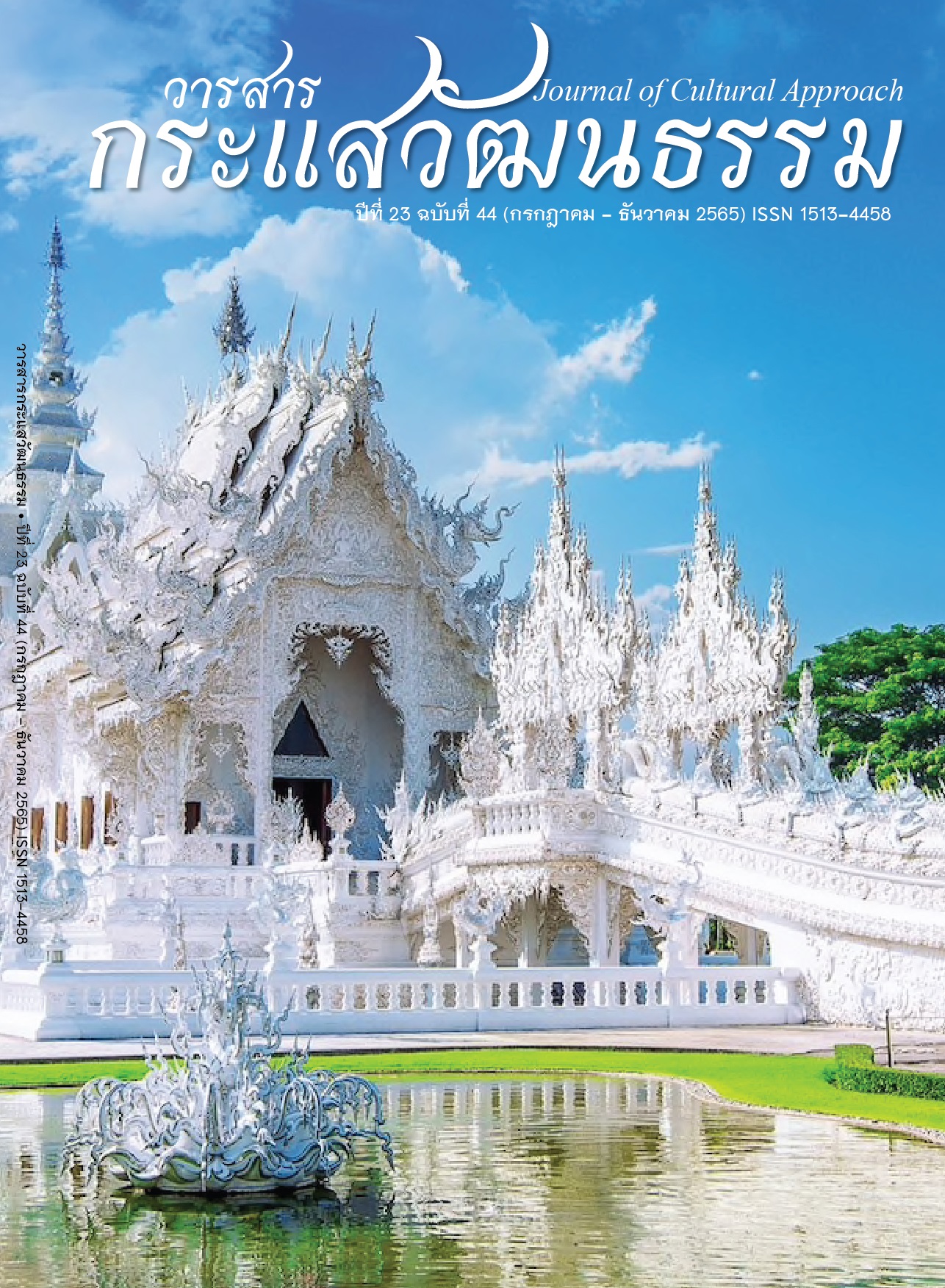การจัดทำคลังข้อมูลชุมชนบ้านห้วยปูแกง ตำบลผาบ่อง อำเภอเมือง จังหวัดแม่ฮ่องสอน
Main Article Content
บทคัดย่อ
การวิจัยนี้มีวัตถุประสงค์เพื่อรวบรวมข้อมูลประวัติศาสตร์ชุมชน และจัดทำแผนผังชุมชน ปฏิทินชุมชน และข้อมูลอัตลักษณ์ทางวัฒนธรรม ของกลุ่มชาติพันธุ์ กะยัน กะยา กะยอ ปกาเกอะญอ และไทใหญ่ ในหมู่บ้านห้วยปูแกง ตำบลผาบ่อง อำเภอเมือง จังหวัดแม่ฮ่องสอน โดยการมีส่วนร่วมของชุมชน เป็นการวิจัยเป็นการวิจัยเชิงปฏิบัติการแบบมีส่วนร่วม เน้นการเรียนรู้จากการปฏิบัติ ที่ให้ชาวบ้านเข้ามามีส่วนร่วมในการวิจัย ทำการศึกษาข้อมูลจากเอกสาร เก็บข้อมูลภาคสนาม ด้วยการสังเกต สัมภาษณ์ เส้นประวัติศาสตร์ แผนผังชุมชน ปฏิทินชุมชน ประชุมระดมสมอง และสนทนากลุ่ม
ผลการวิจัยพบว่า ชุมชนบ้านห้วยปูแกง เป็นที่อาศัยของผู้อพยพหนีภัยสงครามจากประเทศพม่า เมื่อปี พ.ศ. 2527-2528 จนถึง ปี พ.ศ. 2563 โดยเหตุการณ์สำคัญที่เกิดขึ้นได้นำมาลำดับและเรียบเรียง โดยจัดทำเป็นเส้นประวัติศาสตร์ชุมชน เพื่อช่วยให้ชุมชนเข้าใจเรื่องราว เห็นพัฒนาการความเป็นมา และการเปลี่ยนแปลงที่เกิดขึ้นจากอดีตถึงปัจจุบันของหมู่บ้านห้วยปูแกง และมีการจัดทำแผนผังชุมชน ปฏิทินชุมชนและข้อมูลอัตลักษณ์ทางวัฒนธรรม ของกลุ่มชาติพันธุ์ ซึ่งมีชาวกะยัน กะยา กะยอ ปกาเกอะญอ และไทใหญ่อาศัยอยู่ โดยนำข้อมูลมาจัดระบบการบันทึกสำหรับทำคลังข้อมูลในรูปแบบดิจิทัลเก็บไว้ในระบบฐานข้อมูลของศูนย์มานุษยวิทยาสิริธร (องค์การมหาชน) และมีการเผยแพร่ข้อมูลผ่านทางสื่อสังคมออนไลน์
Article Details

อนุญาตภายใต้เงื่อนไข Creative Commons Attribution-NonCommercial-NoDerivatives 4.0 International License.
Proposed Creative Commons Copyright Notices
1. Proposed Policy for Journals That Offer Open Access
Authors who publish with this journal agree to the following terms:
- Authors retain copyright and grant the journal right of first publication with the work simultaneously licensed under a Creative Commons Attribution License that allows others to share the work with an acknowledgement of the work's authorship and initial publication in this journal.
- Authors are able to enter into separate, additional contractual arrangements for the non-exclusive distribution of the journal's published version of the work (e.g., post it to an institutional repository or publish it in a book), with an acknowledgement of its initial publication in this journal.
- Authors are permitted and encouraged to post their work online (e.g., in institutional repositories or on their website) prior to and during the submission process, as it can lead to productive exchanges, as well as earlier and greater citation of published work (See The Effect of Open Access).
Proposed Policy for Journals That Offer Delayed Open Access
Authors who publish with this journal agree to the following terms:
- Authors retain copyright and grant the journal right of first publication, with the work [SPECIFY PERIOD OF TIME] after publication simultaneously licensed under a Creative Commons Attribution License that allows others to share the work with an acknowledgement of the work's authorship and initial publication in this journal.
- Authors are able to enter into separate, additional contractual arrangements for the non-exclusive distribution of the journal's published version of the work (e.g., post it to an institutional repository or publish it in a book), with an acknowledgement of its initial publication in this journal.
- Authors are permitted and encouraged to post their work online (e.g., in institutional repositories or on their website) prior to and during the submission process, as it can lead to productive exchanges, as well as earlier and greater citation of published work (See The Effect of Open Access).
เอกสารอ้างอิง
Aneksuk, B. & Ruangkamnerd, A. (2010). Dynamic of Boon Kam Fa Tradition of Phuan Ethnic Group in the Thailand Tourism Context. WIT Transactions on Ecology and the Environment, 139(1), 411–422.
Barth, F. (1969). Ethnic Groups and Boundaries. The Social Organizations of Cultural Differences, Boston : Little Brown and Company.
Chaisri, N. (2018). Project for Reviewing and Establishing in the Pracharat Tourism Marketing Route Mae Hong Son Province. Social Research Institute, Chiang Mai University.
Chantavanich, S. (2011). Data Analysis in Qualitative Research. Bangkok : Chulalongkorn University Press.
Chumpa, N. & Techathammawong, Y. (2021). The Tourism Management Based on the Social Capital of Ethnic Communities in Maesalong-Nok Sub-district, Mafahluang District, Chiang Rai Province. Journal of Cultural Approach, 22(41), 28–42.
Karen Linguistics Project. (2012). Stories from the Thai-Burmese Border : Intellectual Sparks for Sustainable Development. Bangkok : the Thailand Research Fund.
Kunstadter, P. (1967). Southeast Asian Tribes, Minorities, and Nations. United States : Princeton University Press.
Lanna Cultural and Ethnographic Museum Project. (2008). Tai Yai Ethnic Supremacy. Social Research Institute, Chiang Mai University.
Mae Hong Son Provincial Cultural Office. (2006). Cultural History Mae Hong Son Province. Chiang Mai : Charoenwat Printing.
Mae Hong Son Provincial Cultural Office. (2021). The Kayah (the Red Karen) Ethnic Group Information Mae Hong Son Province. Chiang Mai : Darawan Printing.
Phanthong, W. (2011). The Managerial Process of Government towards Long-Neck Karen Villages in Mae Hong Son Province. Faculty of Public Administration, Chiang Mai University.
Popichit, N., Prasitwisate, G., Serirat, S. & Namjaidee, S. (2020). Development of Competency in Creative Tourism Activity of the Thai Song Dam Tribe. Journal of Cultural Approach, 21(40), 53–64.
Sarahongsa, N. (2019). Three Coordinate of Skaw Karen Community Based Cultural Tourism in Mae Hong Son Province. Journal of Cultural Approach, 20(38), 3–16.
Thitikalyakorn, T. (2021). History of Huai Pu Kaeng Village. Mae Hong Son : Huai Pu Kaeng Village.


